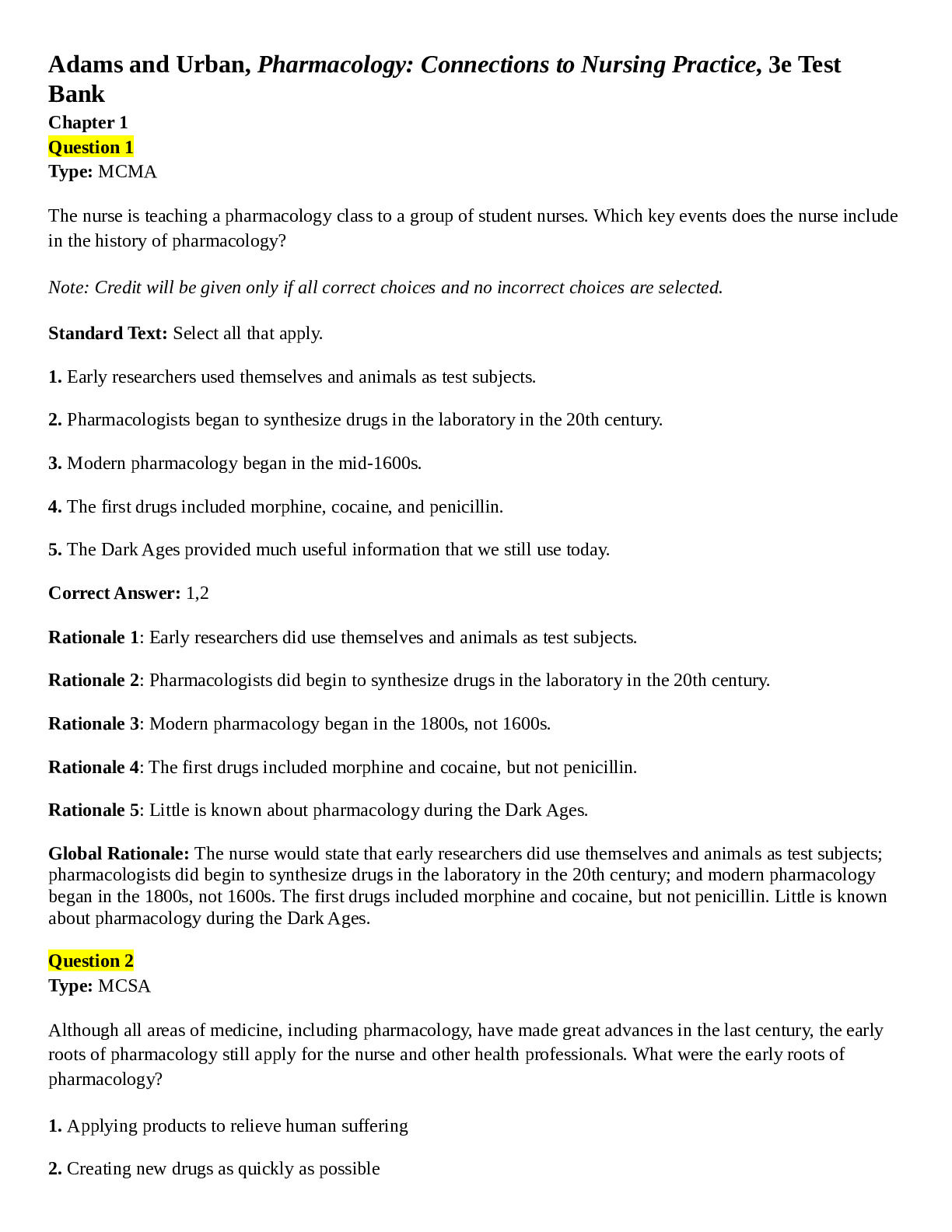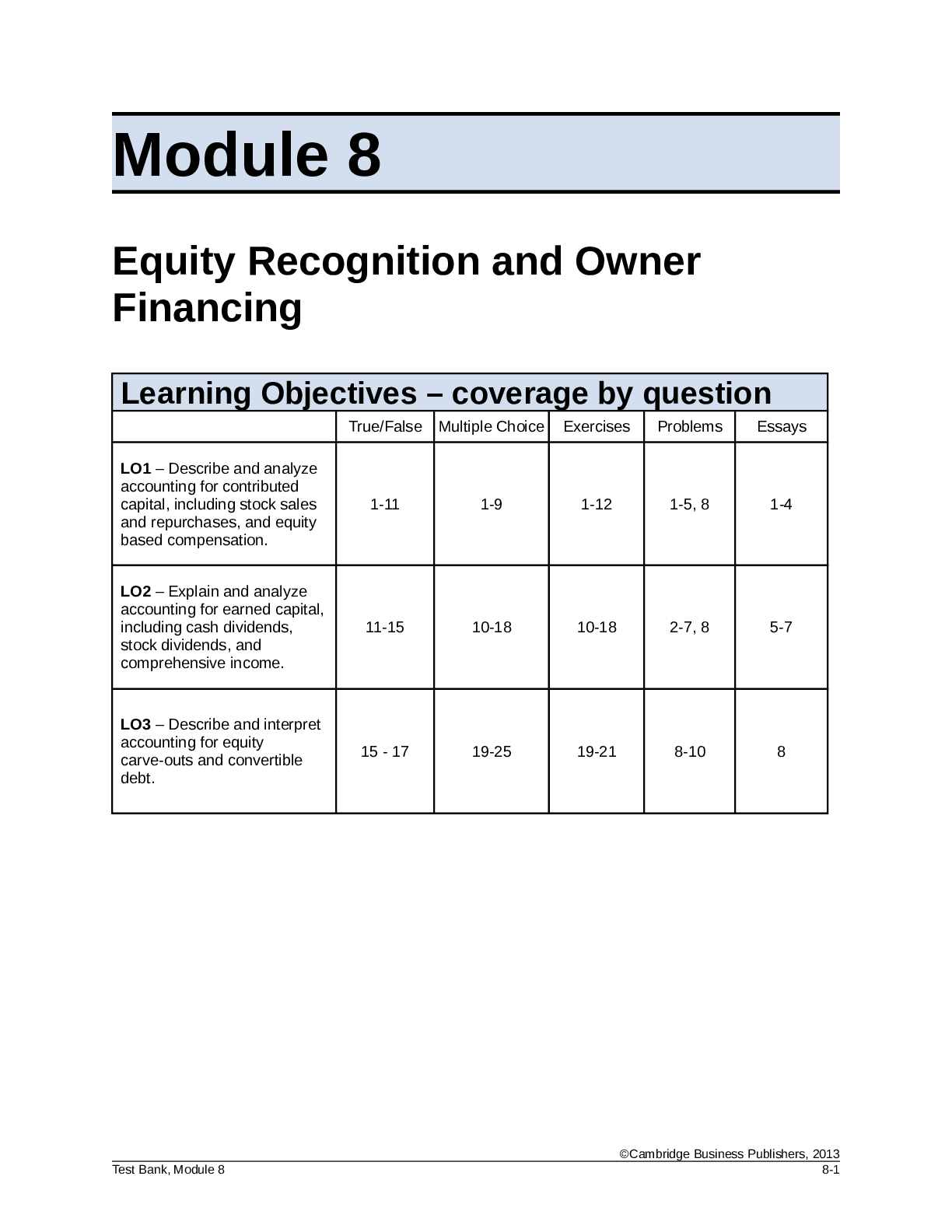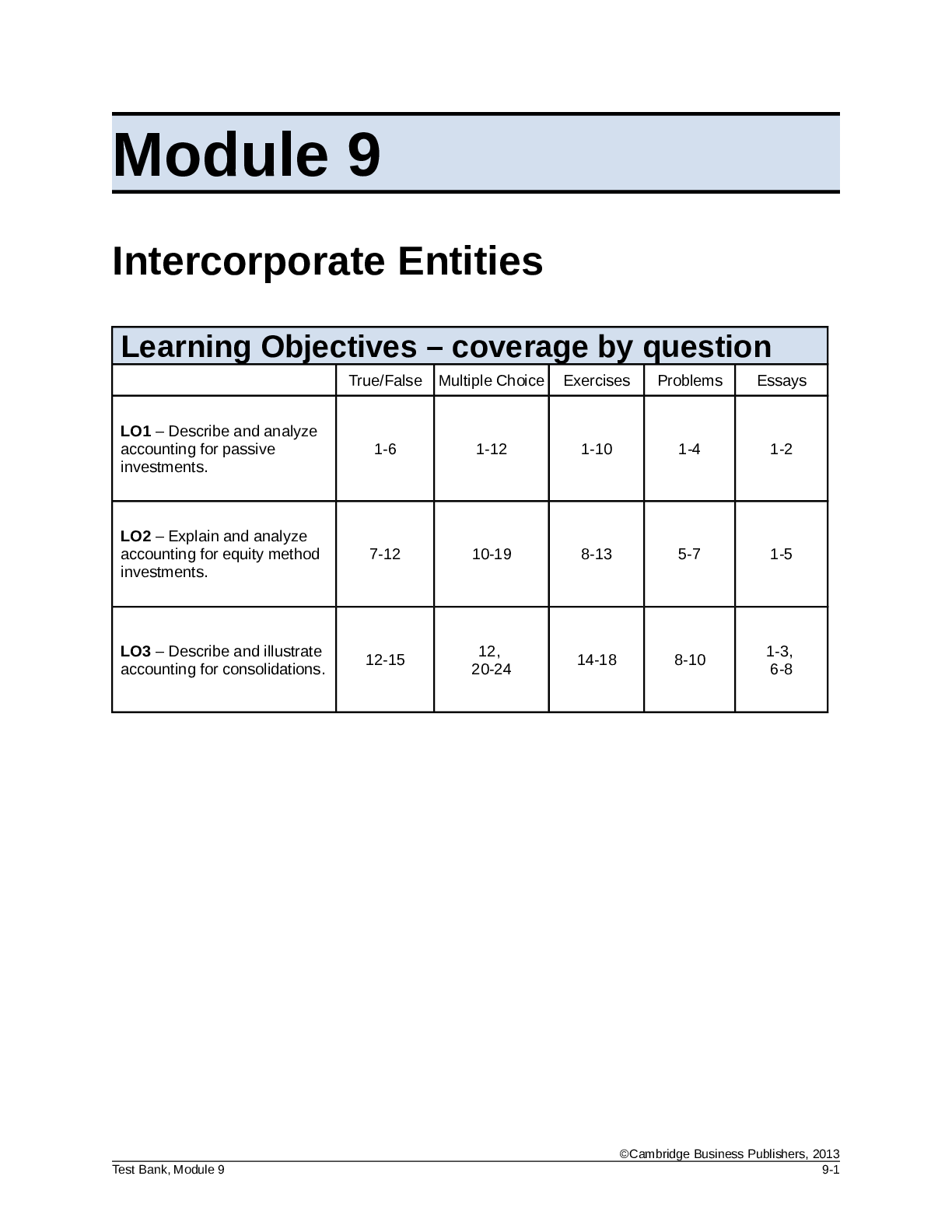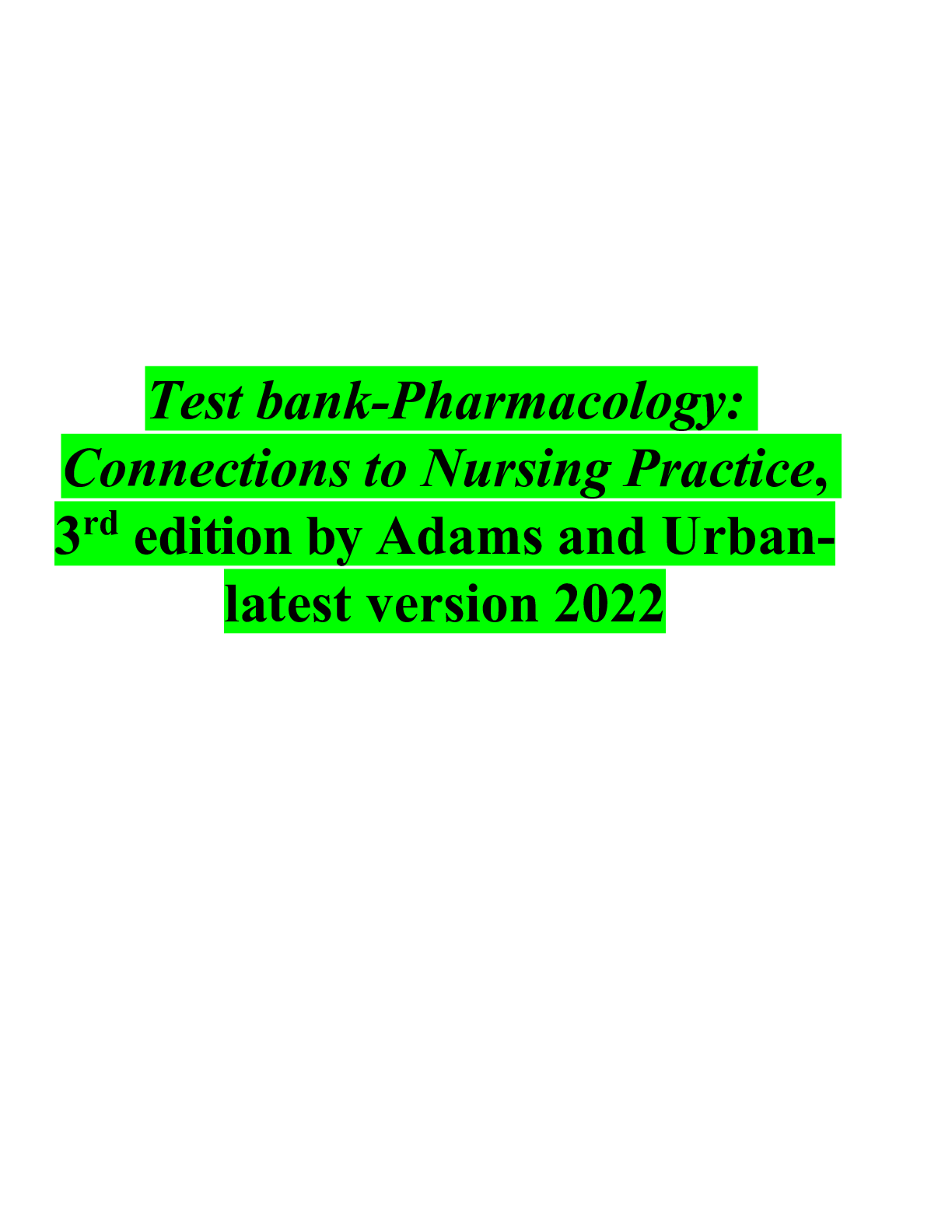*NURSING > TEST BANKS > Adams and Urban, Pharmacology: Connections to Nursing Practice, 3e Test Bank (Latest complete A+ gui (All)
Adams and Urban, Pharmacology: Connections to Nursing Practice, 3e Test Bank (Latest complete A+ guide) deeply elaborated.
Document Content and Description Below
Adams and Urban, Pharmacology: Connections to Nursing Practice, 3e Test Bank Chapter 1 Question 1 Type: MCMA The nurse is teaching a pharmacology class to a group of student nurses. Which key even... ts does the nurse include in the history of pharmacology? Note: Credit will be given only if all correct choices and no incorrect choices are selected. Standard Text: Select all that apply. 1. Early researchers used themselves and animals as test subjects. 2. Pharmacologists began to synthesize drugs in the laboratory in the 20th century. 3. Modern pharmacology began in the mid-1600s. 4. The first drugs included morphine, cocaine, and penicillin. 5. The Dark Ages provided much useful information that we still use today. Correct Answer: 1,2 Rationale 1: Early researchers did use themselves and animals as test subjects. Rationale 2: Pharmacologists did begin to synthesize drugs in the laboratory in the 20th century. Rationale 3: Modern pharmacology began in the 1800s, not 1600s. Rationale 4: The first drugs included morphine and cocaine, but not penicillin. Rationale 5: Little is known about pharmacology during the Dark Ages. Global Rationale: The nurse would state that early researchers did use themselves and animals as test subjects; pharmacologists did begin to synthesize drugs in the laboratory in the 20th century; and modern pharmacology began in the 1800s, not 1600s. The first drugs included morphine and cocaine, but not penicillin. Little is known about pharmacology during the Dark Ages. Question 2 Type: MCSA Although all areas of medicine, including pharmacology, have made great advances in the last century, the early roots of pharmacology still apply for the nurse and other health professionals. What were the early roots of pharmacology? 1. Applying products to relieve human suffering 2. Creating new drugs as quickly as possible 3. Finding medicinal alternatives to plants 4. Understanding how drugs take their effects Correct Answer: 1 Rationale 1: The early root of pharmacology was to relieve human suffering. Rationale 2: The early root of pharmacology was not to create new drugs quickly. Rationale 3: Early pharmacology involved using plants to relieve symptoms of suffering. Rationale 4: The early root of pharmacology was not to understand how drugs take their effects. Global Rationale: The early root of pharmacology was to relieve human suffering, not to create new drugs quickly or to understand how drugs take their effects. Early pharmacology did involve using plants to relieve symptoms of suffering. Question 3 Type: MCSA Although many substances can be considered drugs, which drug definition is the most appropriate? 1. Any substance that is found in nature or that normally occurs in the body 2. Any substance that is synthesized and tested in the laboratory setting 3. Any substance that is taken to prevent, cure, or reduce symptoms of a medical condition 4. Any substance that can be isolated from natural substances in nature Correct Answer: 3 Rationale 1: A drug is not a substance that is found in nature or that normally occurs in the human body. Rationale 2: A drug is not only a substance that is synthesized and tested. Rationale 3: A drug is considered to be any substance that is taken to prevent, cure, or reduce symptoms of a medical condition. Rationale 4: A drug is not only a substance isolated from natural substances. Global Rationale: A drug is considered to be any substance that is taken to prevent, cure, or reduce symptoms of a medical condition. A drug is not a substance that is found in nature or that normally occurs in the human body; it is not any substance that is synthesized and tested in the laboratory setting, nor is it only a substance isolated from natural substances. Question 4 Type: MCSA Pharmacotherapy is a critical intervention for many conditions, and a key part of nursing intervention. Which statement best describes pharmacotherapy? 1. The study of medicine and drug therapy 2. The application of natural substances to cure diseases 3. The application of drugs for the prevention and treatment of disease and human suffering 4. Understanding the difference between trade and generic medications Correct Answer: 3 Rationale 1: Pharmacotherapy is not just the study of medicine and drug therapy. Rationale 2: Pharmacotherapy is not the application of natural substances to cure diseases. Rationale 3: Pharmacotherapy is the application of drugs for the prevention and treatment of diseases and human suffering. Rationale 4: Pharmacotherapy comprises more than understanding the difference between trade and generic drugs. Global Rationale: Pharmacotherapy is the application of drugs for the prevention and treatment of diseases and human suffering. It is not just the study of medicine and drug therapy nor is it the application of natural substances to cure diseases. Pharmacotherapy comprises more than understanding the difference between trade and generic drugs. Question 5 Type: MCSA Which principle best describes what the nurse is expected to understand when administering medication to a client? 1. The pharmacotherapeutics for all of the medications 2. The most common side effects of the drug’s prototype 3. The trade and generic names for all of the medications 4. The cost of the drug therapy Correct Answer: 1 Rationale 1: The nurse should understand the pharmacotherapeutics for all medications that the client is receiving. Rationale 2: The nurse should understand much more about a drug than just the common side effects of the drug’s prototype. Rationale 3: The nurse should understand much more about a drug than just its trade and generic names. Rationale 4: The cost of drug therapy is not a principle of drug administration. Global Rationale: The nurse is expected to understand the pharmacotherapeutics for all medications that the client is receiving. The nurse should understand much more than the common side effects of the drug’s prototype and the trade and generic names. The cost of drug therapy is not a principle of drug administration. Question 6 Type: MCSA The Food and Drug Administration classifies drugs by category, and these categories and drugs are found in the “Orange Book.” To find out which drugs treat hypertension, the nurse would look under which classification? 1. Cardiac 2. Pharmacologic 3. Disease 4. Therapeutic Correct Answer: 4 Rationale 1: There is no cardiac classification. Rationale 2: The pharmacologic category describes how the drug works, not what condition the drug treats. However, the nurse could determine what condition the drug treats by knowing how the drug works. Rationale 3: Disease is not a category. Rationale 4: The nurse would look under the therapeutic category to find out what a drug will treat. Global Rationale: To find out which drugs treat hypertension, the nurse would look under the therapeutic category to find out what a drug will treat. The pharmacologic category describes how the drug works, not what condition the drug treats. However, the nurse could determine what condition the drug treats by knowing how the drug works. Disease is not a category and there is no cardiac classification. Question 7 Type: MCSA The nurse is creating a teaching plan for a client on the cardiac unit and is researching the medications the client is currently taking to understand how each drug produces its effects in the body. To find this information, the nurse looks up which classification for each medication? 1. Therapeutic 2. Cardiac 3. Disease 4. Pharmacologic Correct Answer: 4 Rationale 1: The therapeutic classification describes what condition is being treated by a drug, not how the drug works in the body. Rationale 2: There is no cardiac category. Rationale 3: There is no disease category. Rationale 4: The nurse researches the pharmacologic classification to discover how a drug works in the body. Global Rationale: The nurse researches the pharmacologic classification to discover how a drug works in the body. The therapeutic classification describes what condition is being treated by a drug, not how the drug works in the body. There is no cardiac or disease category. Question 8 Type: MCMA A prototype drug is a single drug in a class and can be compared with all other medications in the class. What are the benefits for the nurse to studying the prototype drug in predicting characteristics of other drugs in the same class? Note: Credit will be given only if all correct choices and no incorrect choices are selected. Standard Text: Select all that apply. 1. Which drugs have the most favorable safety profile 2. Their therapeutic indications 3. Their actions and adverse effects 4. Their specific clinical use 5. Contraindications specific to any drug in that group Correct Answer: 2,3,4 Rationale 1: The prototype drug does not provide a safety profile of other drugs in the same class. Rationale 2: Studying the therapeutic indications of a prototype drug may allow the nurse to predict actions and adverse effects of other drugs in the same group. Rationale 3: By studying the prototype, the nurse can predict the actions and adverse effects of other drugs in the same class. Rationale 4: Studying the prototype drug may allow the nurse to predict the clinical use of another drug in the same class. Rationale 5: Contraindications may differ for specific drugs in the same class as the prototype. Global Rationale: Studying the therapeutic indications of a prototype drug may allow the nurse to predict actions and adverse effects of other drugs in the same group. The nurse can also predict the actions, adverse effects, and clinical uses of other drugs in the same class. The prototype drug does not provide a safety profile of other drugs in the same class. Contraindications may differ for specific drugs in the same class as the prototype. Question 9 Type: MCMA Chemical names are assigned for each drug. What are the major reasons for why nurses usually do not use the chemical name of the drugs? Note: Credit will be given only if all correct choices and no incorrect choices are selected. Standard Text: Select all that apply. 1. They are usually not brief or easy to remember. 2. They are often difficult to pronounce. 3. There is no standard for assigning names. 4. They do not explain the nature of the drug. 5. There is only one chemical name for each drug. Correct Answer: 1,2 Rationale 1: Chemical names are usually not brief or easy to remember. Rationale 2: Chemical names are often difficult to pronounce. Rationale 3: Chemical names are assigned by a standard nomenclature. Rationale 4: Chemical names do explain the nature of the drug. Rationale 5: While it is true each drug has only one chemical name, this is not one of the reasons nurses do not use the chemical name. Global Rationale: Nurses typically do not use the chemical names of drugs because they are not brief or easy to remember and they are often difficult to pronounce. Chemical names are assigned by a standard nomenclature and they do explain the nature of the drug. While it is true each drug has only one chemical name, this is not one of the reasons nurses do not use the chemical name. Question 10 Type: MCSA The trade name for a drug is usually selected to be short and easy to remember. What is the reason the nurse does not use the trade name for a drug? 1. There are no trade names for combination drugs. 2. A drug can have more than one trade name. 3. The trade name will expire and no longer be used. 4. A company might change the trade name for a drug. Correct Answer: 2 Rationale 1: There are trade names for combination drugs. Rationale 2: A drug can have more than one trade name. Rationale 3: The trade name does not expire and will continue to be used. Rationale 4: Companies usually do not change the trade name of a drug. Global Rationale: Nurses typically do not use the trade name of medications because a drug can have more than one trade name. There are trade names for combination drugs. Trade names do not expire, and they will continue to be used. Companies usually do not change the trade name of a drug. Question 11 Type: MCSA Nursing students must memorize the generic names of drugs. What is the primary reason that generic names are used by health care providers over chemical and trade names? 1. A drug can have more than one chemical and trade name. 2. There is only one generic name for each drug, and it is easier to remember than the chemical name. 3. The trade names do not reflect the action of the drug as the generic name does. 4. Nursing students should actually strive to learn both the generic and trade names to avoid confusion with clients. Correct Answer: 2 Rationale 1: A drug has only one chemical name; it can have multiple trade names. Rationale 2: Each drug does have only one generic name. Rationale 3: The generic name of a drug might not reflect the action of the drug. Rationale 4: Nursing students should learn the generic name of a drug, since there can be multiple trade names. Global Rationale: Generic drug names are typically used because each drug only has one generic name, while it can have multiple trade names. Chemical names are not often used because they are hard to remember and pronounce. The generic name of a drug might not reflect the action of the drug. Question 12 Type: MCSA Which is one of the main reasons a pharmaceutical company might be granted an exclusive period to market and distribute a new drug? 1. It allows the company to recoup the cost of research and development. 2. It allows consumers to get used to the trade name of the drug. 3. It allows all the adverse effects to be discovered. 4. Without competition, consumer savings are significant. Correct Answer: 1 Rationale 1: Exclusivity allows a pharmaceutical company a period of time to recoup the costs of research and development of a drug. Rationale 2: The period of exclusivity is not granted so that consumers will become familiar with a trade name. Rationale 3: Adverse effects are discovered during the clinical drug trials, not during the period of exclusivity. Rationale 4: Competition between pharmaceutical companies actually results in consumer savings. Global Rationale: Exclusivity allows a pharmaceutical company a period of time to recoup the costs of research and development of a drug. Exclusivity is not granted so that consumers will become familiar with a trade name. Adverse effects are discovered during the clinical drug trials, not during the period of exclusivity. Competition between pharmaceutical companies actually results in consumer savings. Question 13 Type: MCSA Bioavailability of a drug can be affected by many factors. Which factor does not affect the bioavailability of a drug? 1. Inert ingredients 2. Rate of absorption 3. Safety margin 4. Tablet compression Correct Answer: 3 Rationale 1: Inert ingredients can affect the bioavailability of a drug. Rationale 2: Rate of absorption can affect the bioavailability of a drug. Rationale 3: Safety margin will not affect the bioavailability of a drug. Rationale 4: Tablet compression can affect the bioavailability of a drug. Global Rationale: Safety margin will not affect the bioavailability of a drug. Inert ingredients, the safety margin, and the tablet compression can all affect the bioavailability of a drug. Question 14 Type: MCSA Bioavailability can be different between the generic and trade versions of a drug. When is it not appropriate for a generic drug to be substituted for a trade version? 1. The trade version costs the same as the generic. 2. The time for onset of action is different between the generic and trade versions. 3. The inert ingredients are different in the generic and trade versions. 4. The drug is a critical care drug, or one with a narrow safety margin. Correct Answer: 4 Rationale 1: While the cost of the trade version is usually greater than that of the generic version of the same drug, cost does not affect bioavailability. Rationale 2: The time of onset of action is not always an issue in using the generic over the trade version. Rationale 3: The difference in inert ingredients is not always an issue in substitution of a generic over the trade version. Rationale 4: The nurse should not substitute a generic drug for a trade version if the drug is a critical care drug or has a narrow safety margin. Global Rationale: The nurse should not substitute a generic drug for a trade version if the drug is a critical care drug or has a narrow safety margin. While the cost of the trade version is usually greater than that of the generic version of the same drug, cost does not affect bioavailability. The time of onset of action is not always an issue in using the generic over the trade version. The difference in inert ingredients is not always an issue in substitution of a generic over the trade version. Question 15 Type: MCSA Before administering a drug, what pertinent information must the nurse obtain from the client? 1. Physical assessment, medical history, previous medications, and learning capabilities 2. Medical history, growth and development level of client, and ability to pay for the medication 3. Medical history, client’s growth and development level, and potential adverse effects of the medication 4. Medical history, physical assessment, disease process, and learning needs Correct Answer: 1 Rationale 1: Physical assessment, medical history, previous medications, and learning capabilities are all important pieces of information the nurse should have prior to administering drugs to clients. Rationale 2: Medical history and growth and development are important pieces of information. However, while the client’s ability to pay for the drug is important prescription information, it is not necessary for the nurse to know this prior to administering a drug. Rationale 3: The medical history and growth and development information are important but the nurse would not obtain information regarding potential adverse effects of the medication from the client. Rationale 4: The medical history, physical assessment, disease process, and learning needs are all important information the nurse needs. However, the nurse would not obtain information about the disease process from the client. Global Rationale: Physical assessment, medical history, previous medications, and learning capabilities are all important pieces of information the nurse should have prior to administering drugs to clients. Medical history and growth and development are important pieces of information. However, while the client’s ability to pay for the drug is important prescription information, it is not necessary for the nurse to know this prior to administering a drug. The nurse would not obtain information regarding potential adverse effects of the medication or the disease process from the client. Question 16 Type: MCSA When a drug is ordered for a client, what is the nurse responsible for knowing and understanding about the drug? 1. Name, intended use, special considerations, and adverse effects 2. Drug classification, contraindications, adverse effects, gender considerations, and cost of therapy 3. Drug classification, contraindications, special considerations, and severity of adverse effects 4. Name, intended use, effects, contraindications, special considerations, and adverse effects Correct Answer: 4 Rationale 1: Name, intended use, special considerations, and adverse effects alone do not give the nurse a complete understanding of the drug. Rationale 2: Drug classification, contraindications, and adverse effects are important for the nurse to know. Gender considerations and cost of therapy are not always necessary to know before giving a drug. Rationale 3: Drug classification, contraindications, special considerations, and severity of the adverse effects do not give the nurse all the information needed to protect the client during drug administration. Rationale 4: Name, intended use, effects, contraindications, special considerations, and adverse effects give the nurse the information needed to safely administer the drug as ordered. Global Rationale: Name, intended use, effects, contraindications, special considerations, and adverse effects give the nurse the information needed to safely administer the drug as ordered. Name, intended use, special considerations, and adverse effects alone do not give the nurse a complete understanding of the drug. Drug classification, contraindications, and adverse effects are important for the nurse to know. Gender considerations and cost of therapy are not always necessary to know before giving a drug. Drug classification, contraindications, special considerations, and severity of the adverse effects do not give the nurse all the information needed to protect the client during drug administration. Question 17 Type: MCSA After successfully completing the pharmacology course, a student nurse tells the instructor that he is glad this difficult course is finished. What is the best response from the nursing instructor? 1. “It might be over, but now you will start your clinical courses and apply your knowledge.” 2. “If you think this course was hard, you should try the graduate level.” 3. “Learning is an ongoing process in pharmacology; we must continue to stay up to date.” 4. “Learning difficult material is always painful, but it is necessary.” Correct Answer: 3 Rationale 1: The student will apply the knowledge of drug therapy in the clinical setting, but this does not address the need for lifelong learning in drug therapy. Rationale 2: Telling the student that the graduate course is hard does not address the need for lifelong learning for the student to stay current with drug therapy. Rationale 3: Learning is an ongoing process in pharmacology to stay current with drug therapy. Rationale 4: This statement does not describe the need for lifelong learning to stay competent in the field of pharmacology. Global Rationale: The best response by the nurse is to tell the student that earning is an ongoing process in pharmacology to stay current with drug therapy. The other statements do not address the need for lifelong learning in drug therapy and the field of pharmacology. Question 18 Type: MCMA The client asks the charge nurse how the health care provider will decide which medication to prescribe. The nurses bases the response on which rationale regarding the “ideal drug”? Note: Credit will be given only if all correct choices and no incorrect choices are selected. Standard Text: Select all that apply. 1. Effectively treats, prevents, or cures the client’s condition 2. Is not quickly eliminated by the body so that it can produce its effects over a prolonged period of time 3. Produces minimal adverse effects 4. Produces a rapid and predictable response 5. Is inexpensive and easily accessible Correct Answer: 1,4,5 Rationale 1: The goal of pharmacology is to select a drug that will effectively treat, prevent, or cure a condition. Rationale 2: The goal of pharmacology is to select a drug that will be quickly eliminated by the body after it produces its effects. Rationale 3: The goal of pharmacology is to select a drug that will produce no short-term or long-term adverse effects. Rationale 4: The goal of pharmacology is to select a drug that will produce a rapid, predictable response at relatively low doses. Rationale 5: The ideal drug is affordable and easily accessible. Global Rationale: The goals of pharmacology include selecting a drug that will: effectively treat, prevent, or cure a condition; produce rapid, predictable responses at relatively low doses; and be affordable and easily accessible. Other goals include selecting a drug that will be quickly eliminated by the body after it produces its effects and will produce no short-term or long-term adverse effects. Question 19 Type: MCSA A client is taking a medication for a condition whose indication is not listed and asks the nurse why the health care provider would prescribe this drug. Which response by the nurse is the most appropriate? 1. “Some medications may be used for conditions for which they have not been approved. This is called an ‘off-label’ indication.” 2. “Some medications may be used as a prototype drug for a specific condition and are not listed in the nursing drug handbook.” 3. “A medication can only be used for the specific condition for which it was approved.” 4. “This is a generic drug, and not all generic drugs are in the nursing drug handbook. Only trade name drugs are listed.” Correct Answer: 1 Rationale 1: When a drug is prescribed for a condition for which it has not been approved, this is called an “off-label” indication. Rationale 2: Prototype drugs are the early drugs to which all other drugs in the same class are compared. These drugs are FDA approved and can be found in the nursing drug handbook. Rationale 3: Some drugs are used for conditions for which they have not been approved. Rationale 4: All drugs, generic or trade name, are listed in the nursing drug handbook. Global Rationale: When a drug is prescribed for a condition for which it has not been approved, this is called an “off-label” indication. This is the most appropriate response by the nurse. Prototype drugs are the early drugs to which all other drugs in the same class are compared. These drugs are FDA approved and can be found in the nursing drug handbook. Some drugs are used for conditions for which they have not been approved. All drugs, generic or trade name, are listed in the nursing drug handbook. Question 20 Type: MCMA A client is admitted to the emergency department with high blood pressure. The health care provider orders a diuretic and tells the client this medication will lower the blood pressure by decreasing intravascular fluid volume. What does this description address? Note: Credit will be given only if all correct choices and no incorrect choices are selected. Standard Text: Select all that apply. 1. The drug’s mechanism of action 2. The drug’s pharmacologic classification 3. How the drug produces its effects in the body 4. The drug’s therapeutic classification 5. What condition is being treated by the drug Correct Answer: 1,2,3 Rationale 1: Mechanism of action describes how a drug produces its effects in the body—in this case, how it lowers blood pressure. Rationale 2: The pharmacologic classification describes how a drug produces its effects in the body—in this case, how it lowers blood pressure. Rationale 3: The diuretic lowers blood pressure by lowering fluid volume in the vasculature. Rationale 4: The therapeutic classification states what condition the drug is used to treat. Rationale 5: A drug’s therapeutic classification states what condition the drug is used to treat. Global Rationale: This description addressed the mechanism of action, the pharmacologic classification, and how the drug produces its effect on the body. The description does not address the therapeutic classification which states what condition the drug is used to treat. Question 21 Type: MCMA A client who is admitted to the intensive care unit for monitoring notices the arthritis medication does not look like the one used at home and asks the nurse why. Which response by the nurse is the most appropriate? Note: Credit will be given only if all correct choices and no incorrect choices are selected. Standard Text: Select all that apply. 1. “This is a different brand from the one you use at home, but it will give you the same pain relief.” 2. “Your health care provider feels we can safely substitute this drug for the drug you use at home.” 3. “This generic drug is the one we have on formulary in the pharmacy. It has the same ingredients as the one you use at home.” 4. “This is what we have in the pharmacy. Go ahead and take it for now and let me know if it doesn’t relieve the pain.” 5. “The medications in the hospital often do not look like the ones you get from the pharmacy.” Correct Answer: 1,2,3 Rationale 1: Most brand-name drugs can be safely substituted with generic drugs. The exceptions to this rule are critical care drugs and drugs with a narrow margin of safety. Rationale 2: Most brand-name drugs can be safely substituted with generic drugs. The exceptions to this rule are critical care drugs and drugs with a narrow margin of safety. Rationale 3: Most brand-name drugs can be safely substituted with generic drugs. The exceptions to this rule are critical care drugs and drugs with a narrow margin of safety. Rationale 4: This response does not let the client know that it is very common to substitute noncritical care medications with various generic or brand-name versions. Rationale 5: This response does not let the client know that it is very common to substitute noncritical care medications with various generic or brand-name versions. Global Rationale: Most brand-name drugs can be safely substituted with generic drugs. The exceptions to this rule are critical care drugs and drugs with a narrow margin of safety. The other responses do not let the client know that it is very common to substitute noncritical care medications with various generic or brand-name versions. Question 22 Type: MCMA A client who received a refill for a medication returns to the pharmacy and says, “This medication is wrong! It doesn’t look anything like my usual prescription.” Which response by the pharmacist would be most appropriate? Note: Credit will be given only if all correct choices and no incorrect choices are selected. Standard Text: Select all that apply. 1. “Your usual prescription drug is too expensive, so I substituted it with a generic one.” 2. “There is no difference between this drug and the one you usually get.” 3. “Our state allows me to substitute a generic drug when the prescription calls for a brand-name drug.” 4. “Don’t worry. Can you see that the generic ingredients are exactly the same?” 5. “This medication is a generic form of your other medication. That is why it looks different. But it has the same ingredients and should work the same way.” Correct Answer: 3,5 Rationale 1: It may be true that the client’s prescription is a brand name and more expensive, but this is not an appropriate explanation for the substitution. Rationale 2: While this may be true, it does not give the client an appropriate explanation for the substitution [Show More]
Last updated: 2 years ago
Preview 1 out of 197 pages
.png)
Buy this document to get the full access instantly
Instant Download Access after purchase
Buy NowInstant download
We Accept:

Reviews( 0 )
$20.00
Can't find what you want? Try our AI powered Search
Document information
Connected school, study & course
About the document
Uploaded On
Feb 12, 2021
Number of pages
197
Written in
Additional information
This document has been written for:
Uploaded
Feb 12, 2021
Downloads
0
Views
119

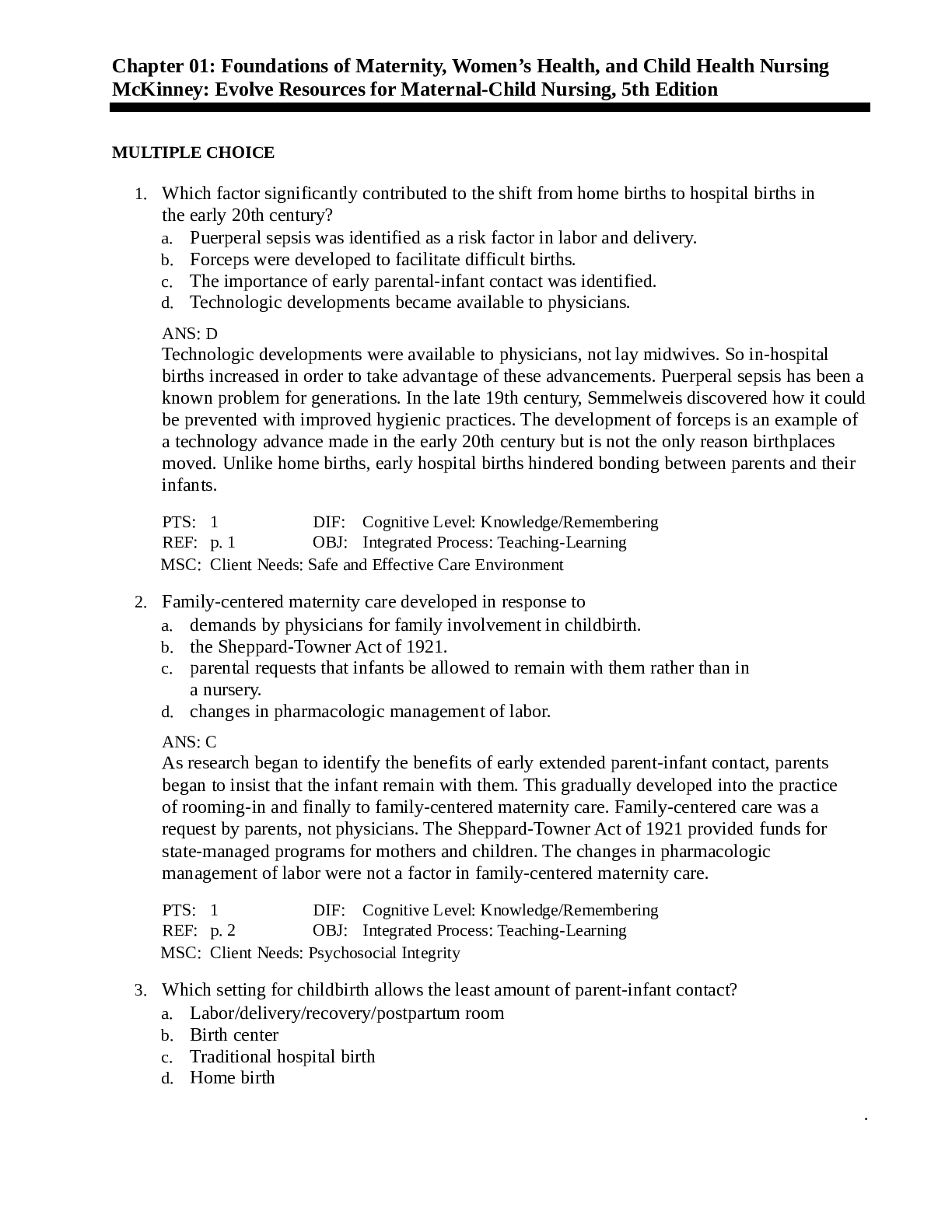
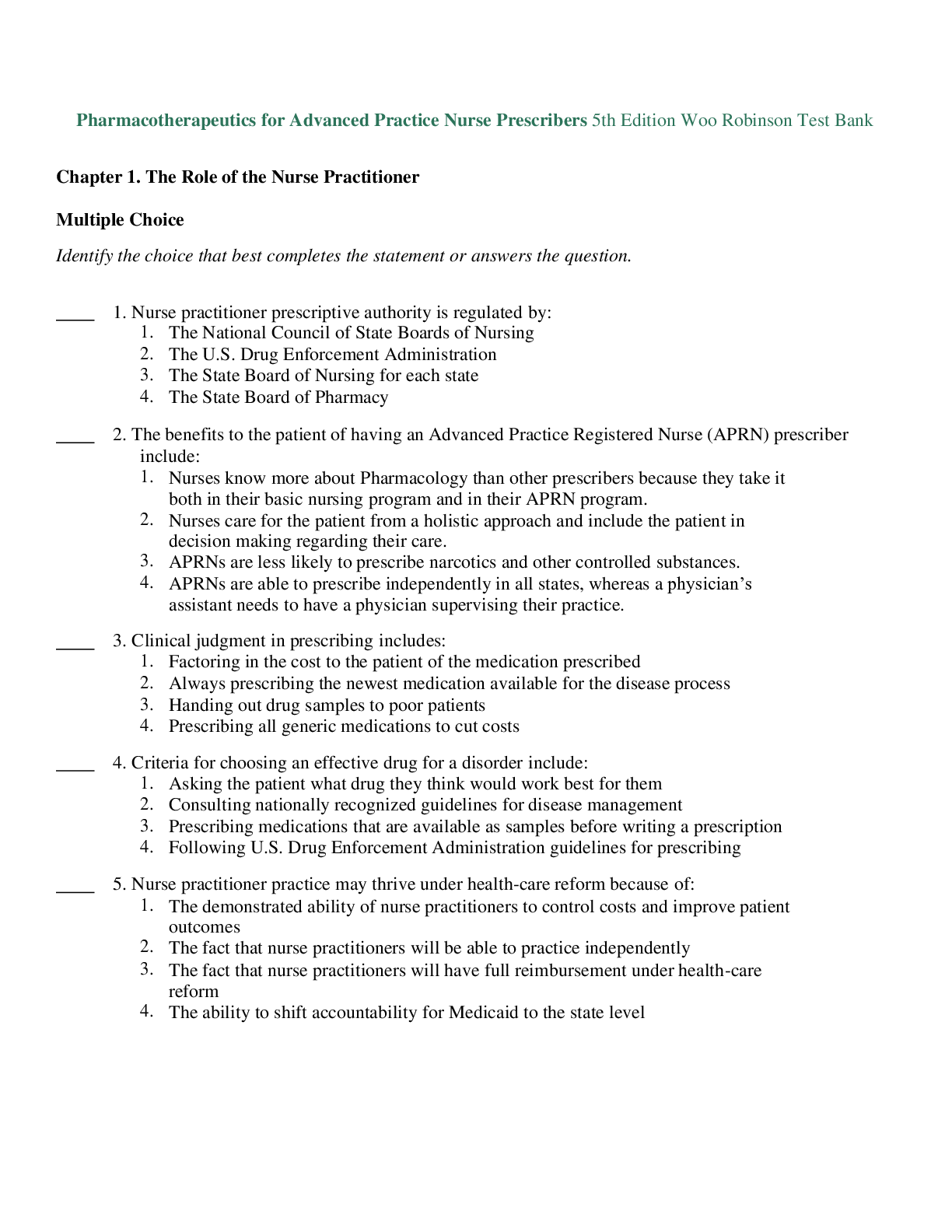


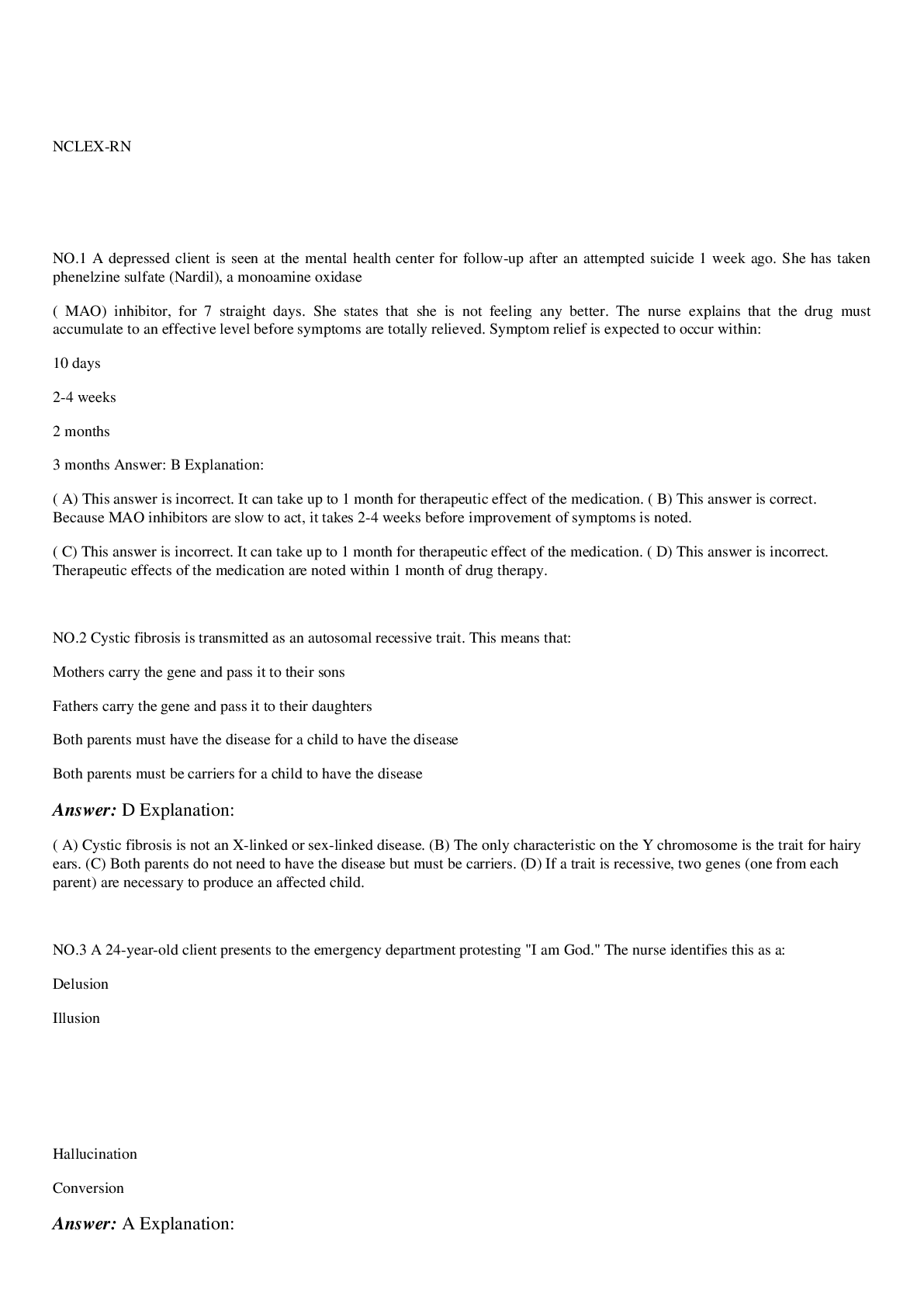




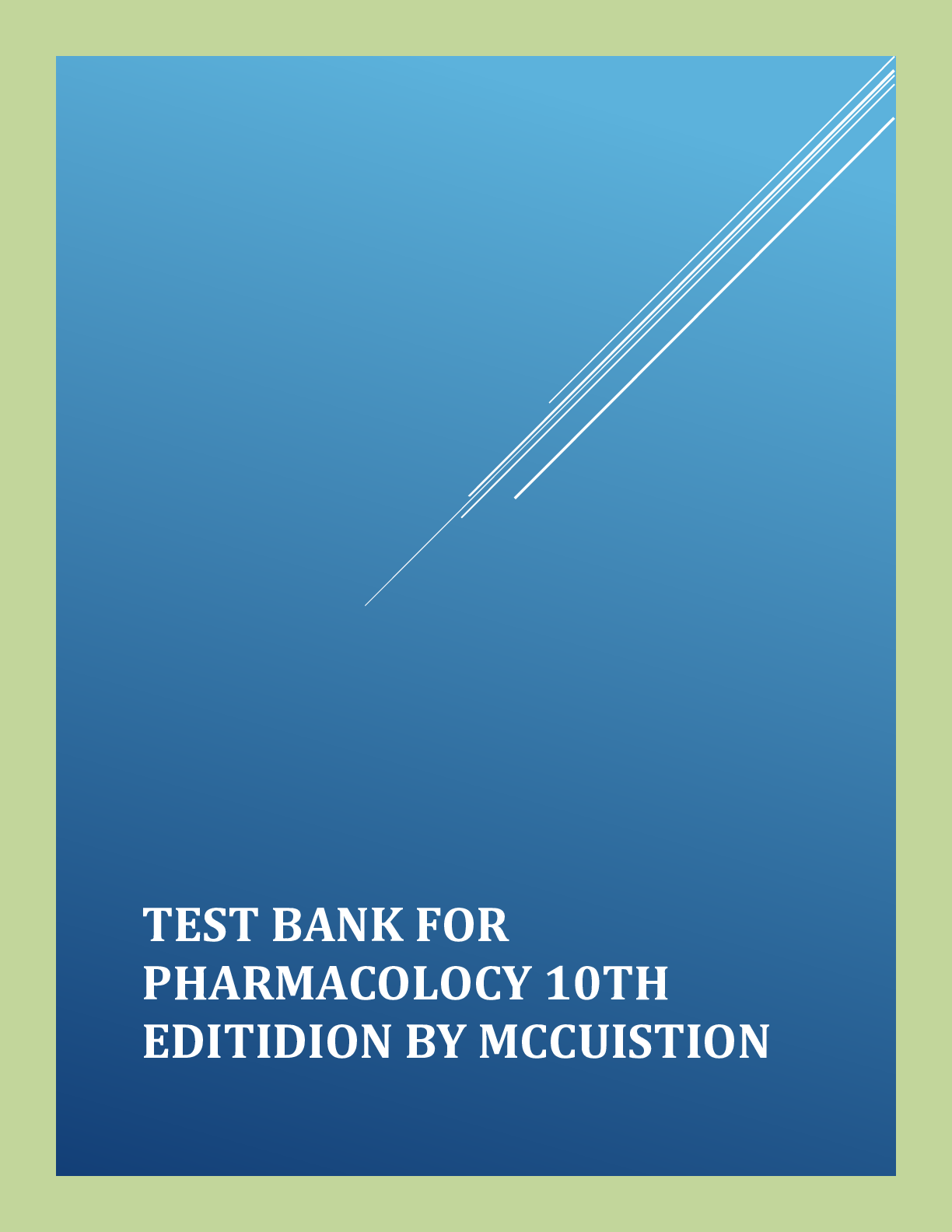


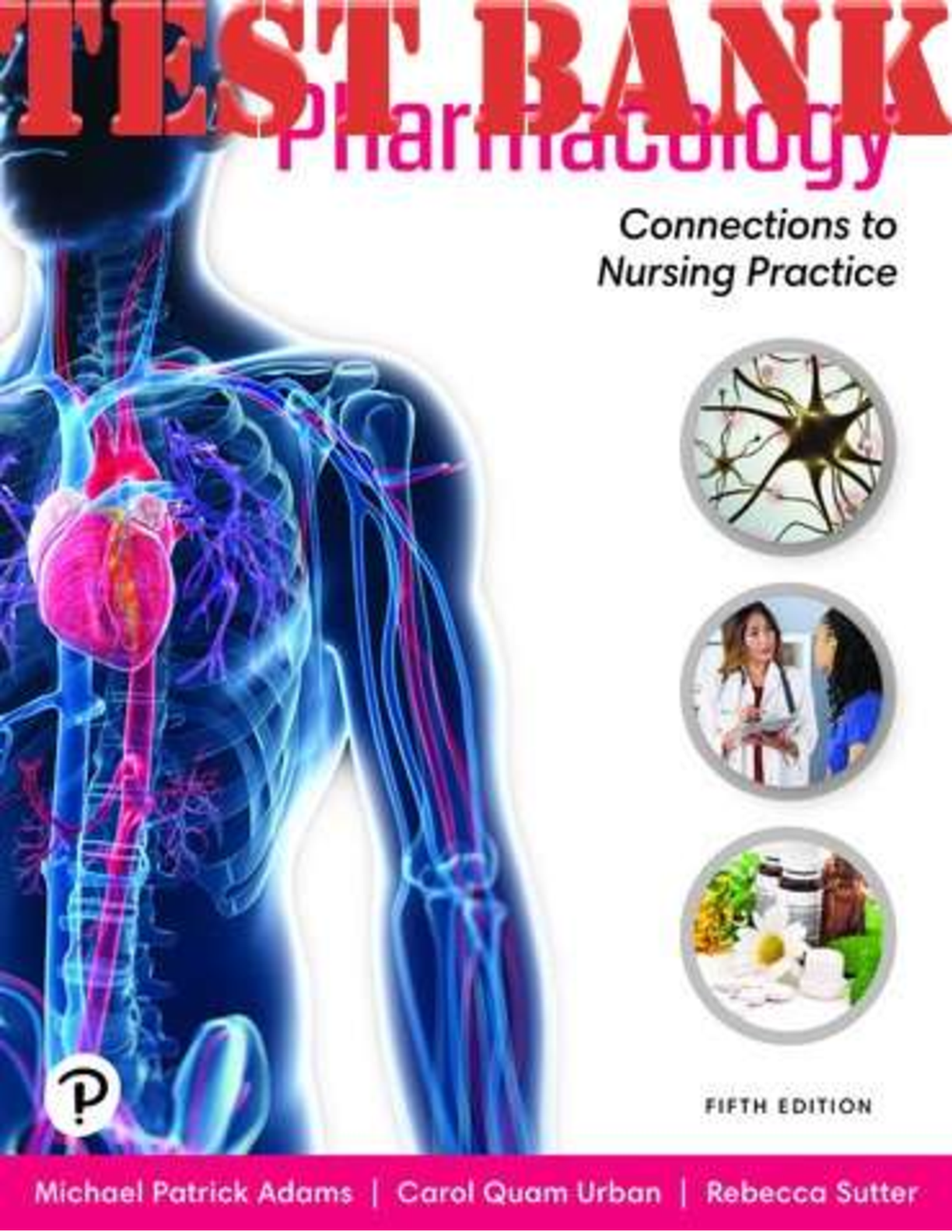

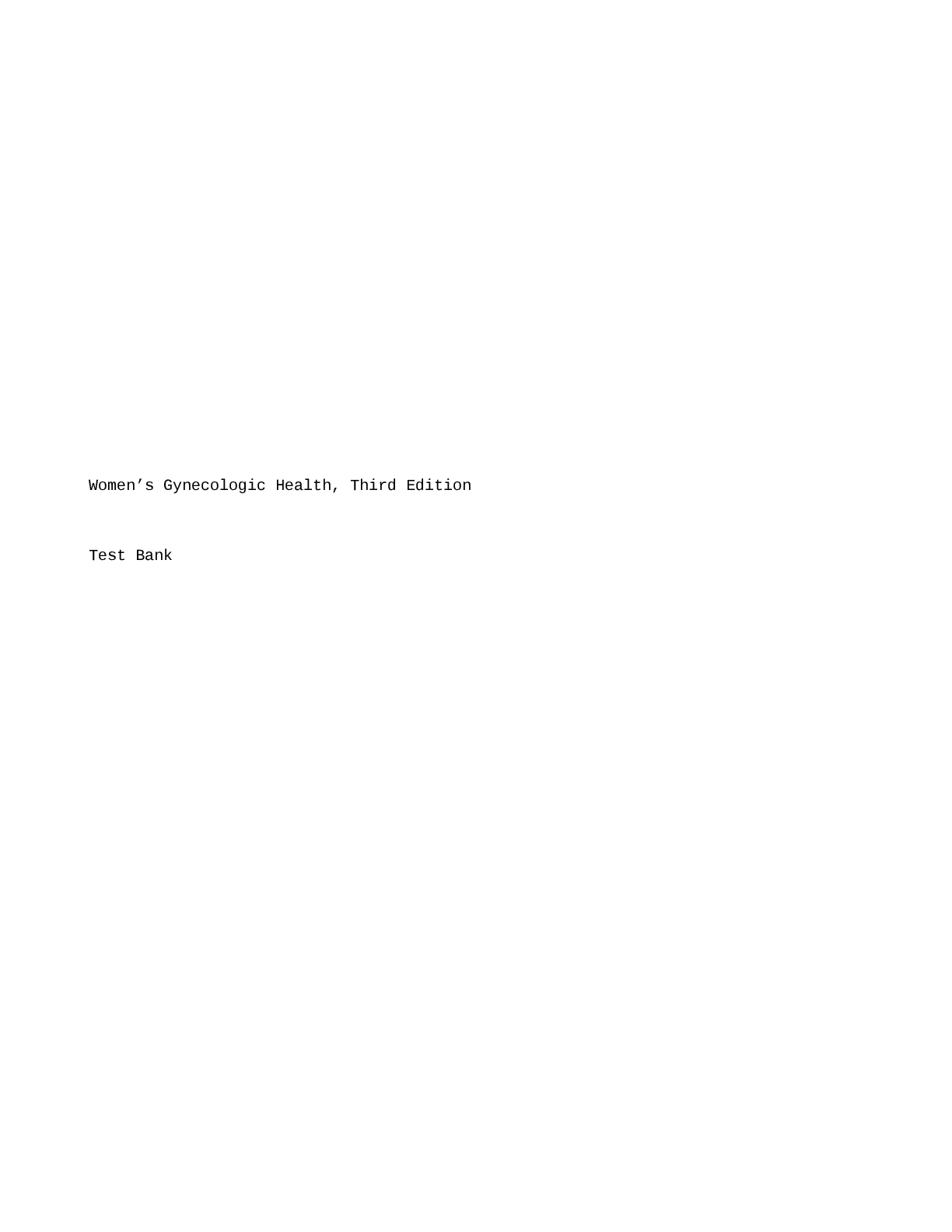
.png)
